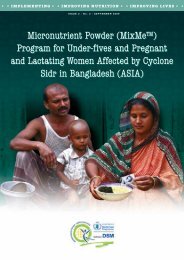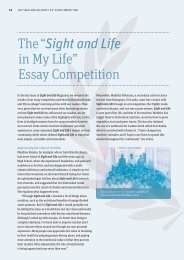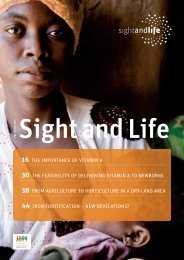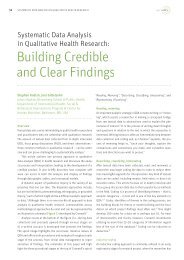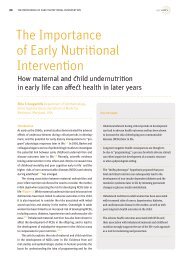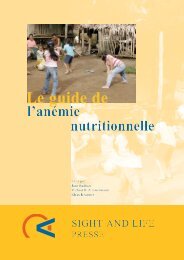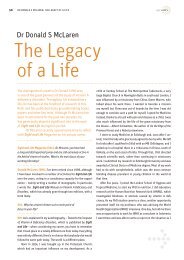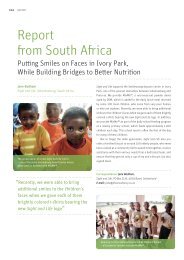16 intrauterine programming of ncd 24 olson memori... - DSM
16 intrauterine programming of ncd 24 olson memori... - DSM
16 intrauterine programming of ncd 24 olson memori... - DSM
- No tags were found...
Create successful ePaper yourself
Turn your PDF publications into a flip-book with our unique Google optimized e-Paper software.
SIGHT AND LIFE | VOL. 25 (2) | 2011 VITAMIN D AND INFLAMMATION 3939> I speculate that the surgery also activated many components<strong>of</strong> the immune system.> Therefore, the fall in plasma 25(OH)D concentrations may beassociated with a rapid uptake <strong>of</strong> 25-OHD by immune cells,priming innate immune defences in the body.> I speculate that the 25(OH)D results obtained followingsurgery may also be obtained following any infection orinflammatory trauma.> Therefore, the many epidemiological studies showing low25(OH)D concentrations associated with chronic diseasesmay be a consequence <strong>of</strong> those diseases and not the cause.> A worrying feature <strong>of</strong> the surgical study was the persistentdepression in plasma 25(OH)D concentration by 20-25% for3 months following surgery.> We also do not know what implications these results havefor children’s vitamin D status, especially where they may beexposed to frequent infections.edge that sunlight could provide vitamin D was first shown byHarriett Chick after World War I, when she demonstrated thatrickets in children could be cured by irradiation with ultra-violetlight. Cholecalciferol is fat-soluble and stores <strong>of</strong> this compoundare found in adipose tissue. These stores <strong>of</strong> vitamin D are in equilibriumwith plasma 25(OH)D concentration, which is producedin the liver when cholecalciferol undergoes hydroxylation <strong>of</strong> carbon-25.(Figure 1) Plasma 25(OH)D has a half-life <strong>of</strong> approximatelythree weeks and this is longer than all other vitamin D metabolites.2 Further metabolism <strong>of</strong> 25(OH)D is mostly determinedby calcium metabolism. A fall in plasma calcium concentrationsstimulates the formation <strong>of</strong> another hydroxylase enzyme in thekidney, which converts 25(OH)D to 1,25(OH)₂D. 1,25(OH)₂D controlsa number <strong>of</strong> metabolic process that raise plasma calciumconcentrations, either by increasing calcium absorption and/orreleasing calcium from bone. However, the 1α-hydroxylase enzymeand vitamin D receptor is also found in many immune andother cells throughout the body 4 so 1,25(OH)₂D has other, nonclassical,functions. These important functions necessitate amuch tighter control over plasma 1,25(OH)₂D than 25(OH)D concentrationsand the half-life is only four hours. 2 Concentrationsin plasma <strong>of</strong> 25(OH)D and 1,25(OH)₂D differ almost 1000-fold(nmol/L and pmol/L).Interpretation <strong>of</strong> plasma25-hydroxy-cholecalciferol concentrationsIn my previous commentary on vitamin D, 5 a major concern wasthe reproducibility <strong>of</strong> plasma 25(OH)D measurements, interassayvariation and appropriate cut-<strong>of</strong>fs to assess those at risk<strong>of</strong> vitamin D deficiency. The methodological issues were understudy at that time by the UK Food Standards Agency; the subsequentreport indicates the most reliable methods. The reportalso points out the newly available Reference Material from theNational Institutes <strong>of</strong> Standards and Technology, which shouldimprove inter-laboratory comparisons. 6 Newer studies willtherefore be better able to assure accuracy; however, the problem<strong>of</strong> interpretation may, if anything, have worsened if plasmaconcentrations <strong>of</strong> 25(OH)D are influenced by inflammation. 1 Appropriatecut-<strong>of</strong>fs to assess the risk <strong>of</strong> vitamin D deficiency arestill not resolved. Deficiency is generally regarded as 50, >80 7 oreven >150 8 nmol/L.In terms <strong>of</strong> functional vitamin D concentration, some workersconsider it is best to assess the free (ie unbound) concentration inplasma, 9 although this is probably not necessary in most clinicalsettings. 2 Most plasma 25(OH)D circulates bound to vitamin D-binding protein (VDBP; 80 – 90%) and most <strong>of</strong> the remainder isbound to albumin (10 –20%). Very little 25(OH)D remains free,ie biologically active in plasma (0.02–0.05%). 10,11 VDBP alsobinds to 1,25(OH)₂D but the relative affinity is 10-fold less thanfor 25(OH)D, so the proportion <strong>of</strong> free plasma 1,25(OH)₂D concentrationsis 10-fold higher compared with 25(OH)D (0.2–0.6%).The concentration <strong>of</strong> VDBP in plasma is 20-fold higher than thetotal amount <strong>of</strong> vitamin D metabolites and the physiological consequence<strong>of</strong> the large molar excess <strong>of</strong> circulating VDBP is unclear.Only 5% <strong>of</strong> the total VDBP capacity is usually occupied by vitaminD compounds; the physiological consequence is thereforethat all circulating vitamin D compounds are protein bound andwill have limited access to target cells. Thus, concentrations <strong>of</strong>free rather than total forms <strong>of</strong> 25(OH)D and 1,25(OH)₂D may providea better assessment <strong>of</strong> functional vitamin D status. 12“Workers suggest that the molarratio <strong>of</strong> 25(OH)D:VDBP or free 25(OH)Dmay be more useful indices <strong>of</strong> biologicalactivity in the plasma than thetotal 25(OH)D concentration alone”The influence <strong>of</strong> variations in the concentration <strong>of</strong> VDBPon the availability <strong>of</strong> the free vitamin D metabolites was clearlyshown in a comparative study <strong>of</strong> patients with idiopathic



